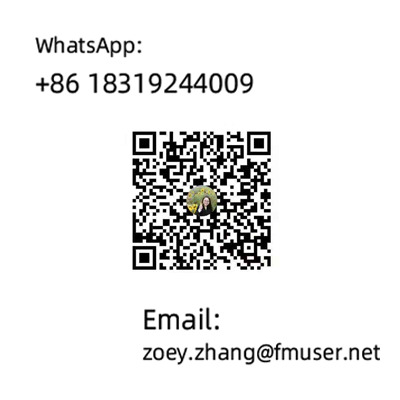Products Category
- FM Transmitter
- 0-50w 50w-1000w 2kw-10kw 10kw+
- TV Transmitter
- 0-50w 50-1kw 2kw-10kw
- FM Antenna
- TV Antenna
- Antenna Accessory
- Cable Connector Power Splitter Dummy Load
- RF Transistor
- Power Supply
- Audio Equipments
- DTV Front End Equipment
- Link System
- STL system Microwave Link system
- FM Radio
- Power Meter
- Other Products
- Special for Coronavirus
Products Tags
Fmuser Sites
- es.fmuser.net
- it.fmuser.net
- fr.fmuser.net
- de.fmuser.net
- af.fmuser.net ->Afrikaans
- sq.fmuser.net ->Albanian
- ar.fmuser.net ->Arabic
- hy.fmuser.net ->Armenian
- az.fmuser.net ->Azerbaijani
- eu.fmuser.net ->Basque
- be.fmuser.net ->Belarusian
- bg.fmuser.net ->Bulgarian
- ca.fmuser.net ->Catalan
- zh-CN.fmuser.net ->Chinese (Simplified)
- zh-TW.fmuser.net ->Chinese (Traditional)
- hr.fmuser.net ->Croatian
- cs.fmuser.net ->Czech
- da.fmuser.net ->Danish
- nl.fmuser.net ->Dutch
- et.fmuser.net ->Estonian
- tl.fmuser.net ->Filipino
- fi.fmuser.net ->Finnish
- fr.fmuser.net ->French
- gl.fmuser.net ->Galician
- ka.fmuser.net ->Georgian
- de.fmuser.net ->German
- el.fmuser.net ->Greek
- ht.fmuser.net ->Haitian Creole
- iw.fmuser.net ->Hebrew
- hi.fmuser.net ->Hindi
- hu.fmuser.net ->Hungarian
- is.fmuser.net ->Icelandic
- id.fmuser.net ->Indonesian
- ga.fmuser.net ->Irish
- it.fmuser.net ->Italian
- ja.fmuser.net ->Japanese
- ko.fmuser.net ->Korean
- lv.fmuser.net ->Latvian
- lt.fmuser.net ->Lithuanian
- mk.fmuser.net ->Macedonian
- ms.fmuser.net ->Malay
- mt.fmuser.net ->Maltese
- no.fmuser.net ->Norwegian
- fa.fmuser.net ->Persian
- pl.fmuser.net ->Polish
- pt.fmuser.net ->Portuguese
- ro.fmuser.net ->Romanian
- ru.fmuser.net ->Russian
- sr.fmuser.net ->Serbian
- sk.fmuser.net ->Slovak
- sl.fmuser.net ->Slovenian
- es.fmuser.net ->Spanish
- sw.fmuser.net ->Swahili
- sv.fmuser.net ->Swedish
- th.fmuser.net ->Thai
- tr.fmuser.net ->Turkish
- uk.fmuser.net ->Ukrainian
- ur.fmuser.net ->Urdu
- vi.fmuser.net ->Vietnamese
- cy.fmuser.net ->Welsh
- yi.fmuser.net ->Yiddish
B、dB、dBm、dBi、dBd、dBc Now You will Know
Bell (B)
Bell (B) was originally used to indicate the ratio of volume power 10 to 1, named after Alexander Graham Bell. Therefore, 1B represents a power ratio of 10:1, which is a logarithmic relationship with a base of 10,100:1=2B and 1000:1=3B. The mathematical relationship is as follows, where P2/P1 represents the power ratio.
Decibel (dB)
It can be seen that Bell is a large unit, so it is inconvenient to use, usually using a smaller unit: decibel (dB), d means "tenth (deci-)", 1B = 10dB, 2B = 20dB, The calculation method is as follows:
10*lg(P2/P1)
In addition to the field of acoustics, decibel has been widely used in many fields such as radio, electric, and mechanics.Bell and decibel do not refer to power itself, but to the ratio of two power values. If a fixed power needs to be represented, then one power is required as a reference and then the absolute power level is expressed in decibels. The most common power benchmarks are mW and W. dBm represents the power decibel value of 1 milliwatt (mW) relative to the reference power, and the conversion formula is as follows:
1W=1000mW=30dBmW=0dBW

Gain and attenuation
We usually hear the word gain, such as antenna gain, amplifier gain, cable attenuation, and so on. Amplifier gain or cable attenuation, everyone knows what it means, this is a ratio, which is the power of the output compared to the input power. If it is greater than 1, it is a positive dB value, that is, it is amplified; if it is smaller than 1 is the negative dB value, that is, the attenuation or loss.
Antenna gain and dBi
The so-called antenna's ability to transmit or receive signals is expressed by the number of decibels of the reference omnidirectional antenna. For example, the antenna gain of 10dBi (10lg(10)) does not mean that the antenna can amplify the power of the signal by 10 times. Instead, the power is concentrated in a certain direction by controlling the angle at which the signal is emitted.
In the case where the input power is equal, the antenna gain refers to the ratio of the power density of the actual antenna and the omnidirectional antenna at the same point in space, and describes the degree to which the antenna concentrates the power, and thus is closely related to the antenna pattern. In general, the narrower the main lobe of the antenna pattern and the smaller the side lobe, the higher the gain.
It can be seen from the antenna pattern that there are different gains in different directions in the space. The antenna gain usually refers to the gain in the direction of the maximum gain, in units of dBi or dBd. The reference units of the two units are different. The former is based on an omnidirectional antenna and the latter is based on a dipole antenna.
Calculation example:
A certain size signal is generated at a certain distance over a certain distance. With an ideal omnidirectional antenna, it is assumed that 100W input power is required, and if a directional antenna with a gain of G=20dBi is used as the transmitting antenna, the input power only needs to be 100/1020/10=1W.
The gain of the dipole antenna is G = 0 dBd = 2.15 dBi.
If you often hear people say that the antenna gain is how many dB, in fact, this is not rigorous, if you hear it is dBi, but to know how much dB is different from the gain of the amplifier.
dBc
Sometimes we will also see the dBc unit, which is generally relative to the carrier power, used to measure the relative value of the carrier power, such as the same frequency / intermodulation / cross / out of band interference or spurs Measured value.
10lg (.) and 20lg (.)
1mV=1000uV=(20*lg(1000))dBuV=60dBuV
If you would like to build a radio station, boost your FM radio transmitter or need any other FM equipment, please feel free to contact us: [email protected].





